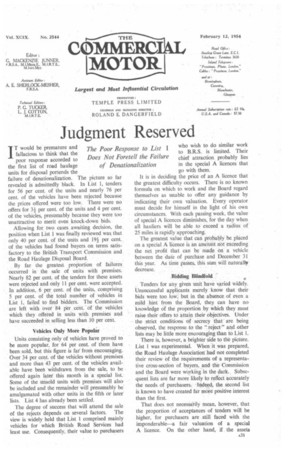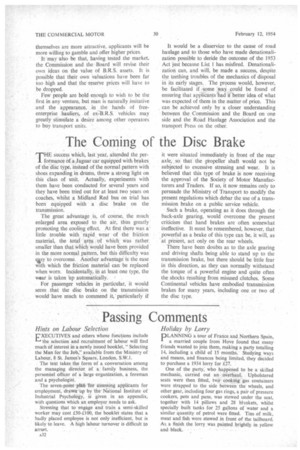Judgment Reserved
Page 33

Page 34

If you've noticed an error in this article please click here to report it so we can fix it.
IT would be premature and fallacious to think that the poor response accorded to the first list of road haulage units for disposal portends the failure of denationalization. The picture so far revealed is admittedly black. In List 1, tenders for 56 per cent. of the units and nearly 76 per cent. of the vehicles have been rejected because the prices offered were too low. There were no offers for 3i per cent. of the units and 4 per cent. of the vehicles, presumably because they were too unattractive to merit even knock-down bids.
Allowing for two cases awaiting decision, the position when List 1 was finally reviewed was, that only 40 per cent. of the units and 191 per cent. of the vehicles had found buyers on terms satisfactory to the British Transport Commission and the Road Haulage Disposal Board.
• By far the greatest progortion of failures occurred in the sale of units with premises. Nearly 82 per cent. of the tenders for these assets were rejected and only 11 per cent. were accepted. In addition, 6 per cent. of the units, comprising 5 per cent. of the total number of vehicles in List 1, failed to find bidders. The Commission are left with over 84 per cent. of the vehieles which they offered in units with premises and have succeeded in selling less than 10 per cent.
Vehicles Only More Popular Units consisting only of vehicles have proved to be more popular, for 64 per cent. of them have been sold, but this figure is far' from encouraging. Over 34 per cent. of the vehicles without premises and more than 43 per cent. of the vehicles available have been 'withdrawn from the sale, to be offered again later this month in a special list. Some of the unsold units with premises will alsobe included and the remainder will presumably be amalgamated with other units in the fifth or later lists. List 4 has already been settled.
The degree of success that will attend the sale of the rejects depends on several factors. The view is widely held that List 1 comprised mainly vehicles for which British Road Services had least use. Consequently, their value to purchasers who wish to do similar work to B.R.S. is limited. Their chief attraction probably lies in the special A licences that go with them.
It is in deciding the price of an A licence that the greatest difficulty occurs. There is no known formula on which to work and the Board regard themselves as unable to offer any guidance by indicating their own valuation. Every operator must decide for himself in the light of his own circumstances. With each passing week, the value of special A licences diminishes, for the day when all hauliers will be able to exceed a radius of 25 miles is rapidly approaching.
The greatest value that can probably be placed on a special A licence is an amount not exceeding the net profit that can be made Iltin a vehicle between the date of purchase and December 31 this year. As time passes, this sum will natural!!
decrease. .
Bidding Blindfold • Tenders for arty given unit have varied widely. Unsuccessful applicants merely know that their bids were too low; but in the absence of ,even mild hint from the Board, they can have no knowledge of the proportion by which they must raise their offers to attain their objectives. Under the strict conditions of secrecy that are being observed, the response to the ".reject-" and. other lists may be little more encouraging than to List 1.
There is, however, a blighter side to the picture. List 1 was experimental. When it was prepared, the Road Haulage Association` had not completed their review of the requirements of a representative cross-section of buyers, and the Commission and the Board were working in the dark. Subsequent lists are far more likely to reflect accurately the needs of purchasers: -Indeed, the second list is known to have created far more positive interest than the first.
That does not necesia'rily mean, however, that the proportion of acceptances of tenders will be higher, for purchasers are still faced with the imponderable—a fair valuation of a special A licence. On the other hand, if the assets themselves are more attractive, applicants will be more willing to gamble and offer higher prices.
It may also be that, having tested the market, the Commission and the Board will revise their own ideas on the value of B.R.S. assets. It is possible that their own valuations have been far too high and that the reserve prices will have to be dropped.
Few people are bold enough to wish to be the first in any venture, but man is naturally imitative and the appearance, in the hands of freeenterprise hauliers, of ex-B.R.S. vehicles may greatly stimulate a desire among other operators to buy transport units. It would be a disservice to the cause of road haulage and to those who have made denationalization possible to deride the outcome of the 1953 Act just because List 1 has misfired. Denationalization can, and will, be made a success, despite the teething troubles of the mechanics of disposal in its early stages. The process would, however, be facilitated if some way could be found of ensuring that applicants had a better idea of what was expected of them in the matter of price. This can be achieved only by a closer understanding between the Commission and the Board on one side and the Road Haulage Association and the transport Press on the other.




































































































